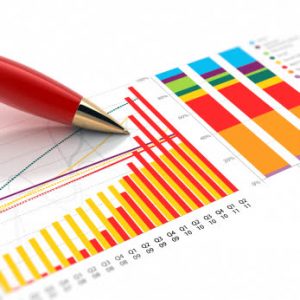Dividend Value Builder Newsletter
Dividend Growth Compounding Versus Interest Compounding
Interest compounding is a powerful financial concept, but dividend growth compounding multiplies the benefits of exponential growth. Compounding occurs when interest or dividends are reinvested and added to what is already there.
Compound growth is geometric or exponential growth (i.e. 1,2,4,8,16,32,64) in contrast to linear growth (i.e. 1,2,3,4,5,6,7). Even though the growth rate may remain the same, the amount of interest or dividends each time period is not constant but increases each successive period of time. This makes time the most important element for taking advantage of this wealth building strategy.
Illustration of Interest Compounding Compared to Dividend Compounding
Here is an illustration to compare and contrast investing in fixed rate investments such as a CD or bond versus investing in a dividend growth stock, or better yet, a portfolio of dividend growth stocks.
Investor A chooses to purchase a fixed rate investment which earns 4% and will reinvest the interest each year. The powerful benefits of compounding are illustrated by the fact the amount of interest each year becomes larger and larger even though the interest rate remains stable at 4%.
In 30 years the fixed rate investment grows over 3 times as big as the original investment. In 50 years the value increases to over 7 times the original investment.
Investor B chooses to invest in dividend growth stocks and participate in compounding through reinvesting dividends. Our illustration assumes a 4% dividend (same as the interest for Investor A) with a modest 3% annual increase in the dividend and stock price.
In 30 years the dividend stocks increase over 7 1/2 times more than the original investment. In 50 years the portfolio grows almost 30 times the original investment. This example is a conservative one. Imagine if Investor B were able to consistently purchase stocks that grow faster than the modest 3% in this example.
|
Interest Compounding |
Dividend Growth Compounding |
||||||||
|
Year |
4% Interest Rate |
Interest Earned Annually |
Total Value |
Dividends Per Share (increases 3% per year) |
Share Price ( increases 3% per year) |
Dividend Reinvest Adds # of Shares |
Total Shares w/ reinvestment of dividends |
Total Value of Shares |
|
|
0 |
100,000 |
100.00 |
1000 |
$100,000 |
|||||
|
1 |
4.00% |
4,000 |
104,000 |
4.00 |
103.00 |
39 |
1,039 |
$107,000 |
|
|
2 |
4.00% |
4,160 |
108,160 |
4.12 |
106.09 |
40 |
1,079 |
$114,490 |
|
|
3 |
4.00% |
4,326 |
112,486 |
4.24 |
109.27 |
42 |
1,121 |
$122,504 |
|
|
4 |
4.00% |
4,499 |
116,986 |
4.37 |
112.55 |
44 |
1,165 |
$131,080 |
|
|
5 |
4.00% |
4,679 |
121,665 |
4.50 |
115.93 |
45 |
1,210 |
$140,255 |
|
|
10 |
4.00% |
5,693 |
148,024 |
5.22 |
134.39 |
55 |
1,464 |
$196,715 |
|
|
15 |
4.00% |
6,927 |
180,094 |
6.05 |
155.80 |
66 |
1,771 |
$275,903 |
|
|
20 |
4.00% |
8,427 |
219,112 |
7.01 |
180.61 |
80 |
2,143 |
$386,968 |
|
|
25 |
4.00% |
10,253 |
266,584 |
8.13 |
209.38 |
97 |
2,592 |
$542,743 |
|
|
30 |
4.00% |
12,475 |
324,340 |
9.43 |
242.73 |
117 |
3,136 |
$761,226 |
|
|
35 |
4.00% |
15,177 |
394,609 |
10.93 |
281.39 |
142 |
3,794 |
$1,067,658 |
|
|
40 |
4.00% |
18,465 |
480,102 |
12.67 |
326.20 |
172 |
4,591 |
$1,497,446 |
|
|
45 |
4.00% |
22,466 |
584,118 |
14.69 |
378.16 |
208 |
5,554 |
$2,100,245 |
|
|
50 |
4.00% |
27,333 |
710,668 |
17.02 |
438.39 |
251 |
6,719 |
$2,945,703 |
|
Investor A has the advantage of exponential growth in interest. But Investor B has several additional advantages that multiply the benefits of exponential growth compounding. When reinvesting dividends more shares of an appreciating asset are purchased. As Investor B adds shares his stock dividends become larger and larger because of additional shares, but also because he is benefiting from the increase in the dividends per share.
Making Dividend Growth Investing Practical
Interest compounding and dividend compounding works with any investment amount and can be multiplied many times over by making annual or regular contributions to a portfolio. Starting early greatly enhances the advantages because delaying investments, even for short periods of time, subtracts from investment returns due to the fact benefits are back loaded.
Dividend growth investing combines the benefits of compounding dividends, compounding the growth of dividends per share, and the increasing value of the shares themselves. The key principle is to take advantage of the power of exponential growth by reinvesting growing dividends over long periods of time.
Interest compounding and dividend compounding each provide the benefits of exponential growth. A comparison of the two gives an illustration of the extraordinary returns that can be provided by dividend compounding. Implementing a dividend growth investing strategy can provide increasing income and build extraordinary wealth for the patient investor.
Related Reading:
Investing Principles Fundamental to Successful Outcomes
Exponential Growth, Double Time, and the Rule of 72
Disclaimer
While Arbor Investment Planner has used reasonable efforts to obtain information from reliable sources, we make no representations or warranties as to the accuracy, reliability, or completeness of third-party information presented herein. The sole purpose of this analysis is information. Nothing presented herein is, or is intended to constitute investment advice. Consult your financial advisor before making investment decisions.
Minimize Large Portfolio Drawdowns
Invest With Confidence in Less Time - Manage Your Portfolio Without Behavioral Errors

